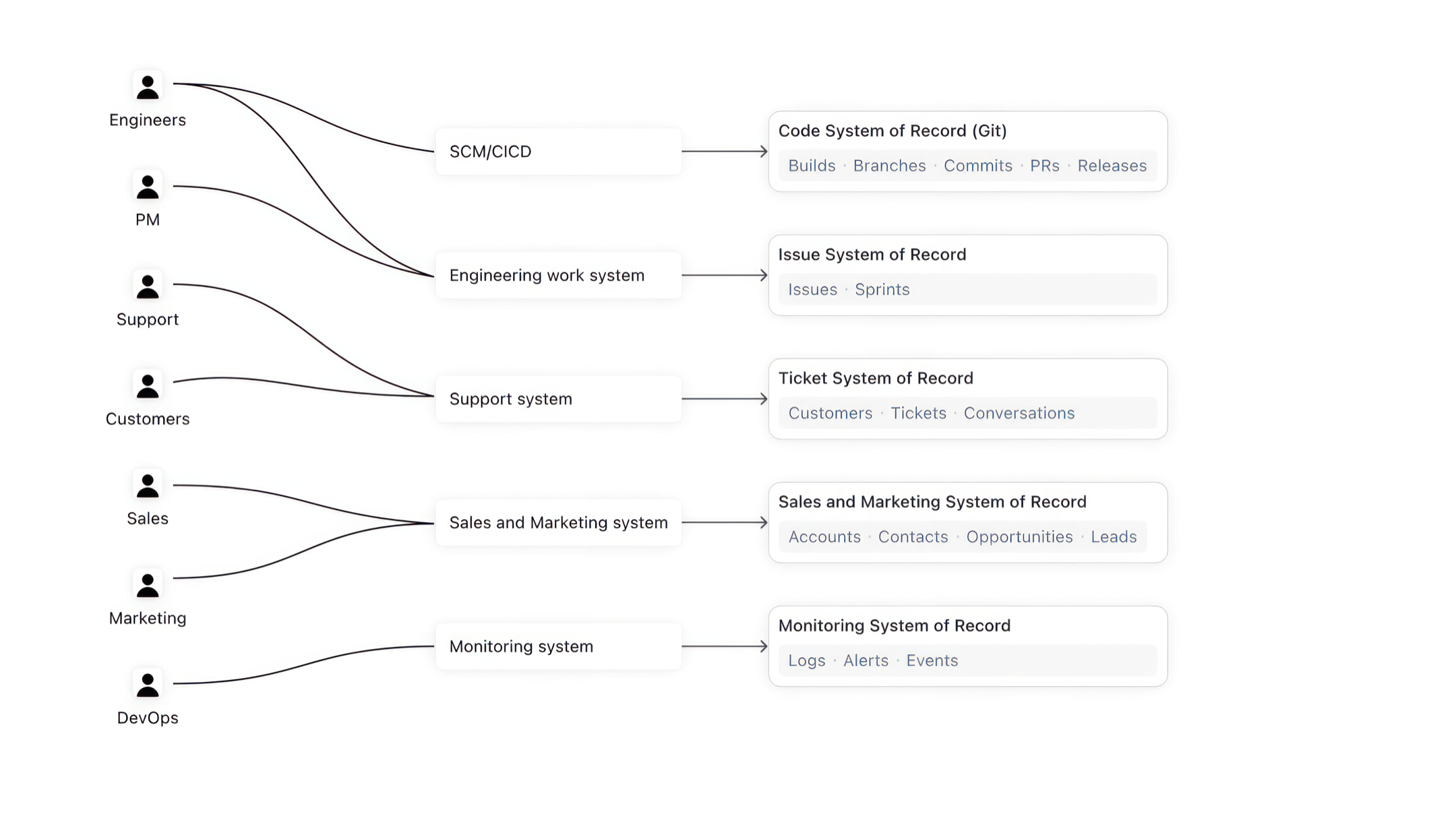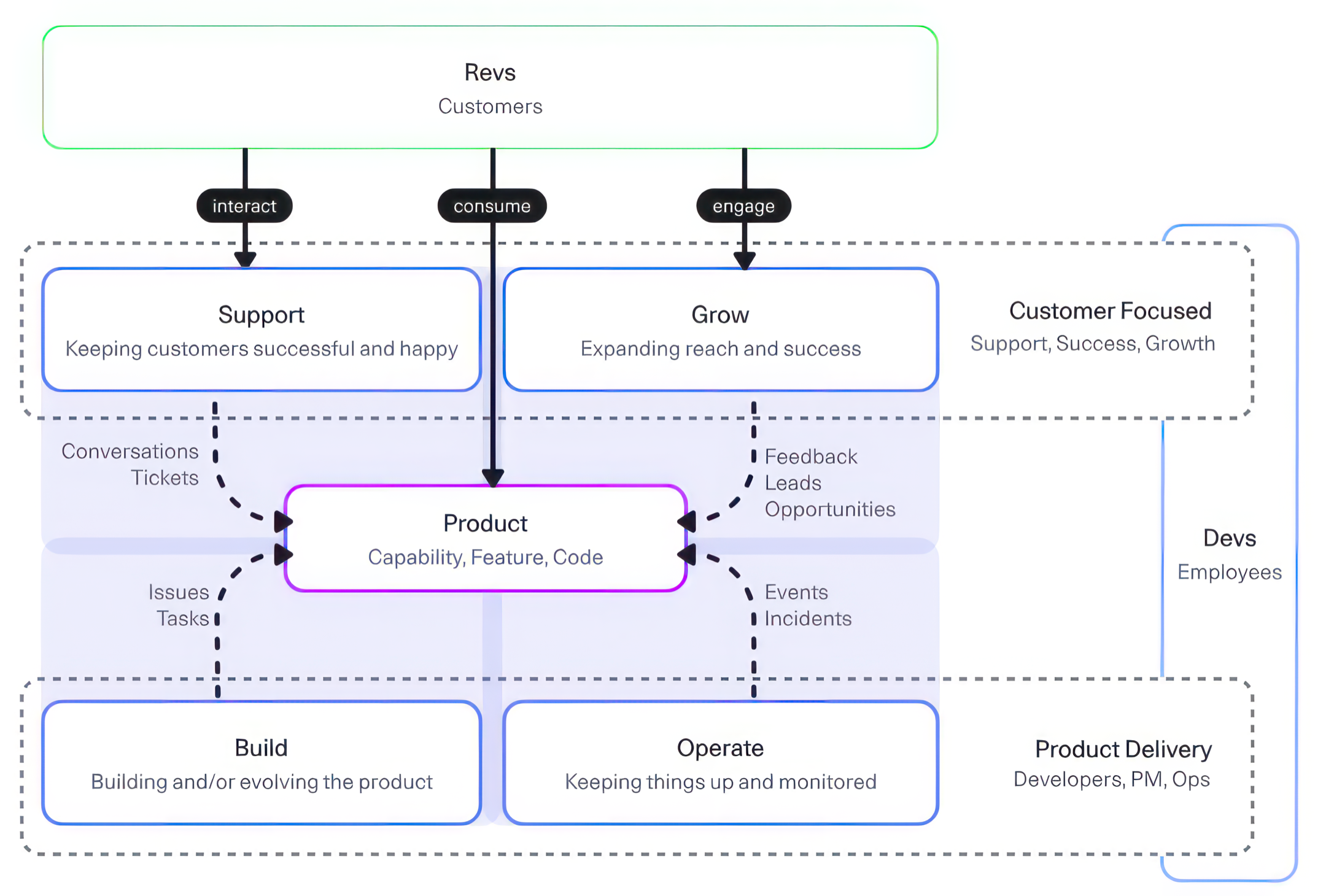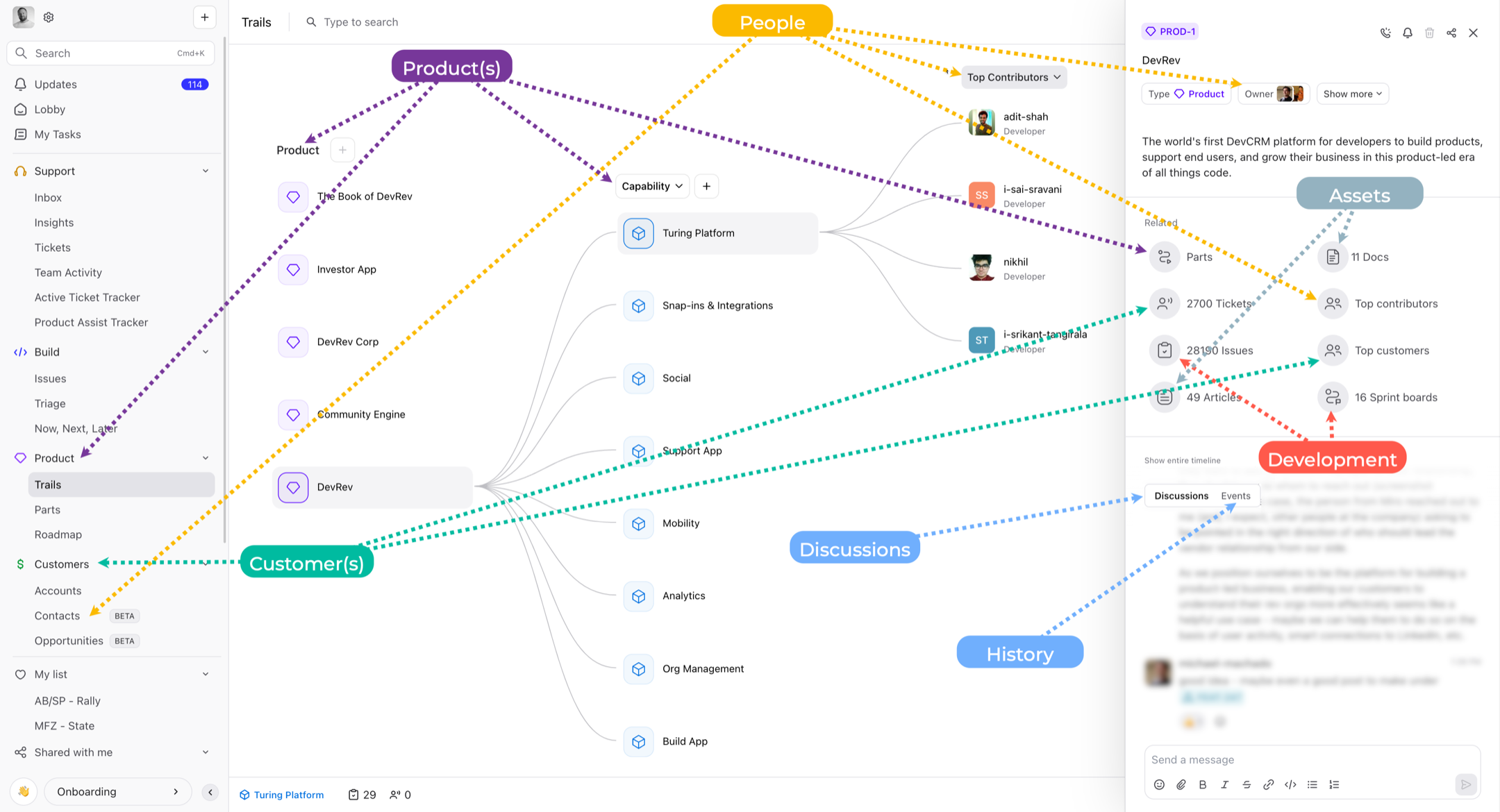
Throughout our relentless exploration of how we could have evolved and approached things from a different perspective, we’ve acquired deep and meaningful understanding. This isn’t just theoretical pondering; it represents the invaluable wisdom we’ve gleaned through our encounters with real-world challenges, are encountering in the present and future alike.
In this section, we dive into the nitty-gritty details and unveil the lessons we’ve learned. We’ve witnessed the stark disconnect between dynamic businesses and their stagnant support systems. And we’ve asked the pivotal question: Why persist with an outdated approach when modern enterprises demand agility?
Our journey continues with the pitfalls of organizations, where we’ve encountered the hurdles of silos, knowledge gaps, and the quest for unity. It’s a journey from the humble beginnings of startups to the complexities of established businesses.
Join us as we share the insights and discoveries that have led us to a new way of thinking about the intricate relationship between business and technology. This is a practical guide, offering invaluable lessons for leaders, innovators, and anyone navigating the ever-evolving landscape of modern enterprise.
The Impedance Mismatch Between Business Evolution and Systems

As businesses have evolved, embracing new paradigms and navigating a rapidly changing landscape, a clear and significant discrepancy has emerged. While businesses have adapted, innovated, and expanded, the systems supporting them have often remained stagnant, unable to keep pace with evolving needs. When you think about the changes just in technology alone, the systems developed even a few years ago will face dramatic challenges or the need for re-platforming or re-writing to fully embrace current technology. For example, some legacy systems still rely on older relational structures, and the shift to a vector database would be a massive undertaking. Similarly, the way systems were built has dramatically evolved including the languages, the interfaces (e.g., APIs and webhooks), and ways things were built (e.g., monolithic vs microservice archtiecture) which can be very limiting when it comes to embracing the latest and greatest.
This incongruity between the dynamic nature of business and the static nature of their supporting systems has raised a critical question: Why persist with an approach that no longer aligns with the demands of modern enterprises? This question has led to a resounding realization that a fundamental shift is imperative.
Challenges related to visibility, efficiency, and effectiveness have underscored the limitations of traditional methods. Consequently, a growing imperative for a new, adaptive solution has emerged to bridge the widening gap between the ever-evolving business landscape and the systems that underpin their operations.
Silos and Organizational Evolution

Allow me to commence with a brief narrative…
In the year 2011, when I embarked on my journey with Nutanix, the landscape was far from auspicious. Our venture lacked a shipping product, customer base, and the product itself was a work in progress. We operated from a single room on Technology Dr. in San Jose, CA, encapsulating those formative “early days” familiar to all startups.
As our product gained traction and viability, we expanded our purview to include dedicated Ops/IT teams, ensuring the stability of our operations. The initial model of our engineering team supporting customers proved unsustainable, prompting the establishment of a dedicated support team, complete with a ticketing system. In parallel, we listened keenly to our early customers, using their insights to evolve our product into something we could confidently promote and sell. Consequently, we welcomed marketing and sales teams into the fold, along with the introduction of then essential tools like Salesforce CRM and Marketo.
In those initial stages, proximity facilitated seamless collaboration and communicmake ration; questions were addressed with a mere shout or a short walk. However, as our business burgeoned, fissures in knowledge sharing and the rise of organizational silos became increasingly evident. Each team cultivated its own system and workspace, with sales on one end of the building and marketing on the other. Over time, these divisions solidified, unintentionally erecting barriers to effective collaboration.
As Nutanix continued to grow, the issue intensified, with these silos becoming even more entrenched. Allocating additional resources, while a common response, failed to address the root problem, and individual productivity remained elusive.
Regrettably, it’s a common tendency for leaders to hoard knowledge, viewing these silos as a form of leverage. However, this mindset, while it may serve their immediate interests, ultimately undermines the greater good of the company. Conversations with numerous individuals and businesses confirmed that this issue wasn’t unique to our organization; it plagued companies of all sizes.
The Inevitable Proliferation of Silos
When contemplating the structure of a company, one inevitably encounters the inclination to build these silos. In most businesses, departments such as Engineering, Support, Sales, Marketing, IT, HR, Finance, and Accounting function as distinct entities, each essential for the company’s success. For optimal efficiency, these units must operate harmoniously; any discord can manifest as inefficiency or, in extreme cases, jeopardize the company’s viability.
Whether by design or circumstance, companies frequently gravitate toward silo creation. As they expand, new departments and leaders often introduce their own systems of record, each demanding its autonomous domain.
The visual below illustrates a typical scenario, where disparate teams operate within their silos, often without shared accounts or integrated systems. This fragmentation leads to duplication, inconsistency, and a lack of coordination, as each team interprets information differently.

The Hidden Costs of Silos
Generally, a series of consequences and impacts tend to arise:
- Coordination Dilemmas and Inefficiency:
- Frequently, each department operates with its individual plans and roadmap, often in isolation.
- This lack of coordination can result in misaligned efforts and even gross duplication of work.
- Operating within silos also leads to inconsistency across departments.
- Knowledge Barriers and Gaps:
- Some may regard knowledge and information as leverage, but this often breeds internal politics, detrimental to business.
- Users are typically confined to their respective systems, lacking access to others.
- For instance, an Engineer might have access to their work system like JIRA or DevRev but not to support systems like ZenDesk or SFDC Service Cloud.
- This leads to fragmented context and a lack of the “big picture.”
- Subpar Employee Experience:
- Silos can foster a competitive rather than collaborative environment.
- Discovering that one’s work has been duplicated elsewhere can be demoralizing.
- Due to the absence of full context and the constant need to relay information between teams, this often results in “work suck.”
- Dismal Customer Experience:
- Few things are as frustrating as encountering a problem, speaking to a support representative, and then a salesperson who’s unaware of the support agent’s actions.
- This frequently leads to inconsistent messaging, portraying a negative image of internal coordination and execution capability to the customer.
But perhaps you’re thinking, “That’s not my problem…” Are you entirely sure?
Let’s consider this from the perspectives of various personas:
Product Manager:
- How would your approach evolve if you had a holistic view encompassing customer requests, product usage, bug tracking, and revenue potential?
- Imagine gaining a comprehensive understanding of your customers, including their support interactions, engagements, and product usage.
- Consider the possibilities of identifying and prioritizing high-impact items based on their revenue implications.
Support Engineer:
- How would your approach change if you knew about potential opportunities or deals with the customer?
- Imagine not having to engage in the tedious task of copying and pasting between engineering issues and your tickets.
- What if you could effortlessly track the status of escalations and have that status automatically reflected in the ticket?
Sales Representative:
- What if you had full visibility and could easily monitor the challenges your customers face, receiving notifications when issues arise?
- What if you could prioritize certain fixes based on deal size?
- Imagine having immediate insight into matters that your customers care about or being promptly notified about new developments from the engineering team.
Customer Success:
- What if there were a unified platform providing clear visibility into your customer’s tickets, opportunities, and relevant engineering issues?
- How would a more coordinated approach impact your customer’s overall experience?
- What if you could prioritize work based upon risk to churn and growth opportunities?
- If a system existed for sharing context, how much manual coordination effort could it save you?
Finance:
- What’s the cost of context-switching and inefficiency within your department?
- If you could save 30 minutes of wasted work daily, what would the opportunity cost savings amount to?
- Consider the cost of an individual being 20% less productive and then extrapolate that to a company-wide scale.
Human Resources (HR):
- How does inefficiency or lack of knowledge affect employee morale?
- Does the manual inefficiency negatively impact their well-being?
- What if you could empower them to be more productive? How would that boost morale?
Whether we embrace it or not, silos cast an impact on everyone within the business, either directly or indirectly. They genuinely influence productivity, experience, efficiency, and, ultimately, the bottom line. So, have you ever considered the true cost of inefficiency for your business?
Unifying Your Product Perspective

When we embark on the journey of managing a product portfolio, numerous critical questions demand our attention. How should we perceive our product lineup? What products are currently at our disposal, and what unique capabilities do they bring to the table? And, perhaps most importantly, how do we make informed decisions about product investments, divestments, or discontinuations?
How we contemplate our products and structure them within our organizational framework constitutes a foundational prerequisite for addressing these intricate inquiries. Without a well-defined and meticulously structured product hierarchy, the fog of uncertainty obscures our vision, leaving us without the clarity needed for effective decision-making.
Commence with the Why
First and foremost, why is this matter of such importance?
Drawing from our past experiences, we encountered formidable visibility challenges stemming from an inability to correlate revenue, costs, and defects with precise granular facets of our products. While we could enact a semblance of this analysis at a crude level, the absence of a mechanism to delineate distinct ROI for each feature imposed significant constraints.
Conversations with fellow founders and leaders in established companies unveiled a shared predicament. While organizations could oversee operations at a macro level, the conundrum of deciphering which features to amplify, curtail, or discontinue in the context of substantial engineering teams remained perplexing. Optimization became paramount, considering the judicious allocation of time, financial resources, and opportunity costs.
Return on investment (ROI) has perennially taken center stage in departments like sales and marketing. For instance, envision a sales representative, with a designated cost structure encompassing base salary, commissions, and travel and entertainment expenses. By quantifying the generated pipeline and revenue, one can effortlessly appraise the ROI for that representative. It bewildered us that analogous objective assessments or granular ROI evaluations weren’t commonplace when it came to products.
One of the fundamental tenets underlying the development of the DevRev platform centered on the insistence that everything must be intrinsically linked to a product and/or customer. But why, you might wonder? The answer is unequivocal: Clarity. By establishing these interconnections, we gain the capacity to address a multitude of probing questions, including but not limited to:
- Which features constitute the primary revenue drivers?
- What features are customers actually using?
- What was the development cost associated with a specific feature?
- Which capabilities exhibit the highest defect rates?
- Which features are experiencing accelerated adoption rates?
- What ROI did a particular feature yield?
The Product Lifecycle

In the realm of modern businesses, a distinct pattern emerges, emphasizing specific areas of focus throughout the lifespan of a product or service.
We’ve broken down this journey into four fundamental quadrants:
- Build
- Focuses on the ideation, creation, and evolution of products or services.
- Operate
- Focuses on the operation, monitoring and incident management of products or services.
- Support
- Focuses on the support and troubleshooting with customers, collaboration with them, and a collaborated effort to minimize churn.
- Grow
- Focuses on the expansion of product adoption including new customer adoption, nurture, awareness and retaining.
The diagram below offers a visual representation of these quadrants and the link back to product:

This comprehensive lifecycle serves as a cornerstone for any organization aiming to retain competitiveness within its industry. It encompasses the multifarious stages a product traverses, commencing from initial design and development, progressing through evolution, and concluding with eventual decline or obsolescence. In this article, we will embark on a high-level exploration of these distinct phases. Subsequent in-depth discussions for each quadrant will follow in dedicated posts.
Note: While primarily applicable to products and services, these quadrants equally pertain to a company and its personnel.
Artificial Intelligence (AI)

In the age of artificial intelligence (AI), change is the only constant. AI’s profound impact on our world, akin to the internet’s transformation, demands our attention. With AI’s undeniable presence, those who resist its embrace risk falling behind.
However, integrating AI into existing systems is no simple feat, especially for products born before the AI revolution. Re-platforming is imperative, but it comes with formidable challenges, including the critical role of context in AI effectiveness, the need for swift adaptation, extensive system redesign, and internal dynamics.
This exploration delves into the pivotal role of context in AI, emphasizes the importance of context for unlocking AI’s potential, and underscores the significance of knowledge graphs. These versatile tools go beyond item similarity, helping us organize and cluster events over time, make informed decisions, and navigate the complexities of our data-driven world. Join us as we navigate the evolving AI landscape, reshaping industries and redefining technology’s role in our lives.
AI will eat the world
“Change is the law of life. And those who look only to the past or present are certain to miss the future.” - John F. Kennedy
Inevitably, AI is becoming an indomitable force, reshaping the very foundations of our world. Much like the advent of the internet, its impact is profound, and those who hesitate to embrace it risk falling behind.
To illustrate this transformation, consider that nearly all the images within this work were crafted with the assistance of AI. This isn’t conjecture; AI is an undeniable reality.
For systems and products conceived prior to the AI revolution, a fundamental re-architecture is imperative to unlock its full potential.
While every vendor may harbor the potential for AI integration, the journey may be riddled with challenges, some surmountable, and others insurmountable. In navigating these waters, it’s wise to apply a litmus test, for often, marketing promises diverge from stark realities.
Here are some formidable challenges they may encounter:
- Limited context impedes their results (you can’t fix what you don’t know; this is paramount).
- Inability to pivot swiftly (turning a tanker is vastly different from steering a small boat).
- Extensive redesign of user interfaces and backend systems (the extent varies but is essential).
- Encounters with internal politics and conflicts (in larger organizations, everyone seeks a slice of the pie).
Context is Key
In the realm of AI, models are only as effective as the context they possess (e.g., training data, fine-tuning data, and embeddings). For instance, both Chat GPT 3.5 and 4.0 were trained on publicly available internet data as of September 2021. Still, they lack knowledge of the current state. AutoGPT and similar innovations aim to bridge this gap by providing the ability to acquire additional context, yet…
That’s not the key, the key is in the data that you have that the models don’t have access to.
The greater the context you can furnish through embeddings or fine-tuning, the more powerful AI becomes in your hands.
The Significance of Knowledge Graphs
Knowledge graphs stand as invaluable tools that facilitate the organization and association of items based on various dimensions. Their utility extends beyond merely establishing item similarity; they excel at the localization and clustering of events over time as well. These can be used to reduce the potential of hallucinations, enhance model viability with fine-tuning and leverage things like reinforcement learning from human feedback (RLHF). The true power of AI is attainable when you can correctly bias it, else you are at fate of training sets.
Knowledge graphs serve a multifaceted purpose, offering the following key advantages:
- Dimensional Clustering: Knowledge graphs enable the grouping of items or entities by considering multiple dimensions simultaneously. This sophisticated clustering ability aids in the identification of intricate relationships and patterns that might otherwise remain concealed.
- Enhanced Similarity Analysis: By incorporating a wide range of attributes and connections, knowledge graphs allow for a comprehensive examination of item similarity. This goes beyond basic comparisons, as it takes into account nuanced relationships and contextual information.
- Temporal Event Clustering: Knowledge graphs are not confined to static data. They excel at clustering events over time, providing a dynamic perspective on how various occurrences are interconnected. This is particularly valuable in fields where temporal analysis is essential, such as historical research, financial markets, and epidemiology.
- Contextual Insights: With knowledge graphs, items are situated within a broader context, fostering a deeper understanding of their significance and relevance. This contextualization can lead to richer insights and more informed decision-making.
- Discovering Hidden Associations: Knowledge graphs have the capacity to unveil hidden associations and dependencies among items. This can be instrumental in fields like network security, fraud detection, and recommendation systems.
- Navigational Efficiency: Knowledge graphs offer efficient navigation through complex datasets. Users can traverse relationships between entities, making it easier to explore and extract valuable information from large, interconnected datasets.
- Machine Learning and AI: Knowledge graphs play a pivotal role in machine learning and artificial intelligence applications. They provide structured data that can be leveraged for training models, improving predictions, and enhancing the understanding of complex systems.
In summary, knowledge graphs are not limited to a single use case or dimension; they are versatile tools capable of uncovering insights, clustering entities, and navigating through intricate datasets. Their ability to capture the essence of relationships and events, both spatially and temporally, makes them indispensable in a wide range of applications across various industries.






